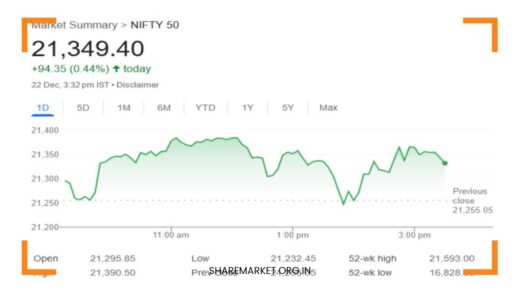Sensex Gains Over 308 Points, Nifty Above 23,550; Nifty Prediction for Tomorrow

Nifty Prediction for Tomorrow
Stock Market Soars: Decoding the Rally and Potential Next Moves
The Indian stock market kicked off the week with a flourish, scaling new heights on June 18th, 2024. Both the benchmark indices, Sensex and Nifty, closed at record levels, reflecting a surge in investor confidence.
This article delves deeper into the market’s performance, analyzes expert opinions, and explores potential future directions.
Unveiling the Market Rally
A closer look reveals a market brimming with enthusiasm. All major indices closed in positive territory. The Sensex climbed by a significant 308 points, reaching a closing figure of 77,301.
The Nifty index mirrored this upward trajectory, gaining 92 points to settle at a new high of 23,558. Positive sentiment extended beyond the headline indices, with the midcap and smallcap indices also registering record closing figures.
This buying spree wasn’t sector-specific. Sectors like realty, PSE (Public Sector Enterprises), and banking emerged as frontrunners, experiencing substantial gains. The IT, energy, and infrastructure sectors also contributed to the positive momentum.
However, a few pockets, including pharma, FMCG (Fast-Moving Consumer Goods), and metal stocks, witnessed some selling pressure.
Enhancing the picture further, the Indian rupee displayed strength against the US dollar. It closed at Rs 83.41 per dollar, registering a gain of 15 paise. This signals a potential influx of foreign investments, potentially fueling further market growth.
Decoding the Technical Landscape
While the current market performance is undeniably bullish, understanding the technical analysis offered by experts is crucial for informed decisions.
Analysts at Kotak Securities emphasize the presence of “higher high” and “higher low” formations on the daily and intraday charts of the Nifty. These formations indicate an upward trend and suggest continued momentum if sustained.
Furthermore, Kotak Securities highlights the significance of support levels. They suggest that 23,500 for Nifty and 77,000 for Sensex act as crucial support zones. A breach below these levels could signal a potential reversal in the trend, prompting traders to re-evaluate their positions.
On the flip side, if the market continues its upward trajectory, analysts predict potential resistance around 23,700-23,750 for Nifty and 77,600-77,800 for Sensex.
However, analysts at LKP Securities offer a slightly different perspective. While acknowledging the eventual rise above 23,500, they identify some sluggishness in the Nifty’s intraday movement.
They emphasize the importance of the support level at 23,300 for Nifty, suggesting that a fall below this point could trigger increased selling pressure. Their upside resistance estimate aligns with Kotak Securities, placing it around 23,800 for Nifty.
Beyond the Numbers: Global Cues and Investor Sentiment
Understanding the market solely through technical analysis is insufficient. Global cues and investor sentiment play a significant role. This rally could be attributed to several factors:
- Positive Global Cues: Recent positive economic data from major economies like the US and the EU might be boosting investor confidence globally, with India being no exception. Optimism regarding global economic recovery could be fueling inflows into emerging markets like India.
- Corporate Earnings Season: The upcoming corporate earnings season holds immense importance. Strong earnings reports from key companies could further bolster investor sentiment and propel markets higher.
- Increased Liquidity: Easy access to credit and ample liquidity in the financial system could be encouraging investors to participate in the market. This increased participation can contribute to rising prices.
However, certain factors could potentially dampen market enthusiasm:
- Geopolitical Tensions: Ongoing geopolitical tensions and potential disruptions in global supply chains could pose a threat to market stability. Investors might become risk-averse in such scenarios.
- Rising Interest Rates: Global central banks are considering raising interest rates to combat inflation. This could lead to reduced liquidity and potentially impact market valuations.
- Domestic Economic Challenges: Domestic factors like inflation and unemployment must also be considered. Any significant deterioration in these areas could dampen investor sentiment.
Navigating the Market Landscape: A Look Ahead
The short-term outlook for the Indian stock market appears positive, with experts maintaining a bullish stance.
However, navigating this dynamic environment requires caution and a thorough understanding of both technical and fundamental factors.
For Investors:
- Focus on Diversification: Investors should prioritize a diversified portfolio across sectors and asset classes to mitigate risk.
- Stay Informed: Keeping abreast of global economic developments, corporate earnings, and potential regulatory changes is crucial.
- Develop an Investment Strategy: Having a clear investment strategy aligned with your risk tolerance and long-term financial goals is essential.
For Businesses:
- Focus on Strong Fundamentals: Delivering strong financial performance, maintaining healthy balance sheets, and demonstrating a commitment to sustainability will be attractive to investors in this environment.
- Embrace Innovation: Adapting to the changing economic landscape and embracing innovation will be key to long-term success.
- Strategic Acquisitions and Mergers: Considering strategic acquisitions and mergers could be an effective way for companies to expand market share and enhance growth potential.
Final Remarks
The Indian stock market’s recent surge reflects a confluence of positive factors. Understanding the technical analysis, global cues, and investor sentiment paint a more comprehensive picture of the market’s dynamics.
While the short-term outlook remains promising, long-term success hinges on a combination of strategic decision-making by businesses and informed investment strategies by individuals.
By remaining adaptable and staying informed, both investors and businesses can navigate the dynamic market landscape and capitalize on potential opportunities.

















